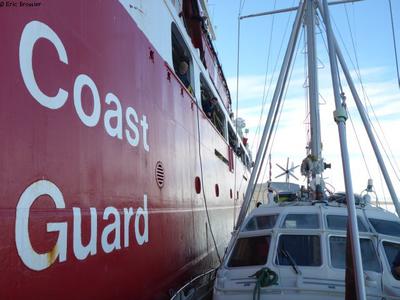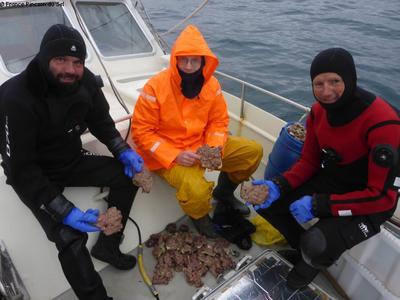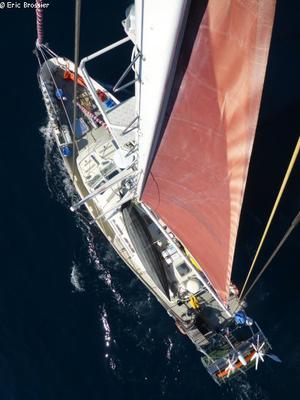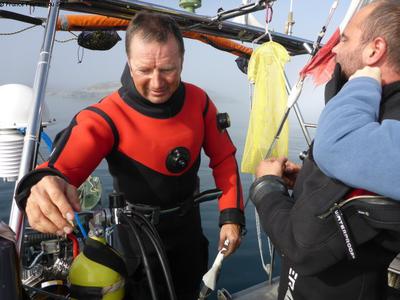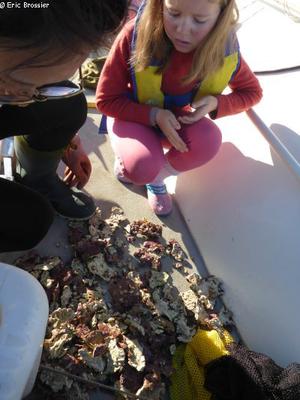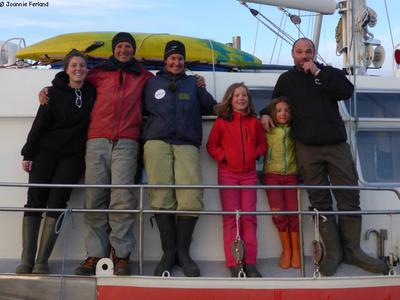From Beechey Island to Beechey Island, via Resolute
August 15: amazing, unexpected collection, at Beechey Island. The few rocks are covered with coralline, sometimes quite thick, and our nets are full at the end of our dive! Jochen is delighted, he will be able to describe the ocean and the climate of past centuries, at Beechey Island, when analysing the samples.
In particular, we might be able to learn more about the conditions endured by the British expedition that looked for the Northwest Passage in 1845. Franklin and his 129 men had spent a first winter here at Beechey Island. Three of them are buried on the beach. Their two ships, the Erebus and the Terror, were abandoned in 1848, a little further in the passage. There was no survivor. For ten years, 40 ships have been seeking their footsteps. It was not until September 2014 that the wreck of the Erebus was found.
This year, about twenty sail boats and a few cruise ships are going through the Northwest Passage, completely free of ice. And even a liner of 1,700 people, a record! While visiting the graves, cairns and remains left on Beechey Island, we found a drone lost the day before by a cameraman from the Ocean Endeavour! Our friend David Reid is guide on board this passenger ship, we will ski together around Bylot island in April (a nice trip ahead!).
Our mission continues in the islands near Resolute Bay. Disappointment, Yves and I cannot find more than very thin fragments of coralline algae. For Jochen, the area around Cornwallis Island was a priority, because we have data on winter sea ice thickness, and he wants to use it when working on the algae samples. After consideration of the geological map of the region, it appears that areas of glaciomarine and marine sediments are not favourable to the development of coralline. Finally, Jochen widely changes our route and the sites to explore.
A little storm is coming, we take refuge in Allen Bay, near Resolute Bay, where Jochen, Pia and Dirk are taking a plane, as expected. While waiting for Alicia, Jochen's student who is joining us to manage the next coralline samples, we spend the day ashore. Besides the Canadian immigration procedure, it is an opportunity to see again the scientific station, the village, and first of all some friends. We are hosted by our friend Joyce, social worker; we met when we lived in Grise Fiord 3 years ago. Fortunately, friends of this remote little village are also in transit in Resolute, we're happy gathering and sharing news with Liza, Geela, Suzie, Eva, Jaypeetee, Mark!
Sailing back from Resolute to Beechey Island is tough, sea is rough. Then we need a full day to rest and repair the staysail which has been damaged by gusty winds. Again, the dives are successful, and Alicia is busy after our dives to sort and inventory all the samples. This is why we came back to Beechey, to make sure we have good samples of coralline. Yves also found a plate, he left it under the sea, following the rules... Maybe Franklin used it 170 years ago?
Each day, we see a different ship stopping at Beechey Island. The Akademik Ioffe, the National Geographic Explorer, the icebreaker Des Groseillers. This one is a Coast Guard ship, we are welcomed on board by the 40 sailors who ensure safety in the Canadian Arctic waters. Vagabond is invited to come along to get some fresh water, to discuss the latest ice charts, to enjoy a meal, and to do a complete tour of the vessel! When leaving the Erebus and Terror Bay, we meet L'Austral. The captain is a friend and sounds the horn, we have an appointment the next day for diner and to give a talk to the 230 passengers.
On the other side of Lancaster, our search for coralline continues at Port Leopold, where Caledonia, a beautiful yacht of a German couple came to anchor next to Vagabond. The opportunity for Celine and France to drink a glass of wine while listening to the story of their Northwest Passage: no wind, no ice, they seem disappointed!
